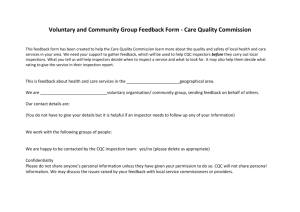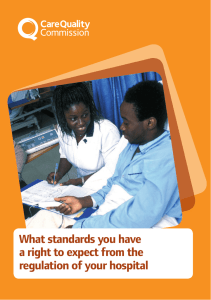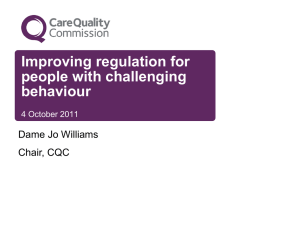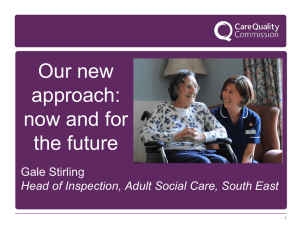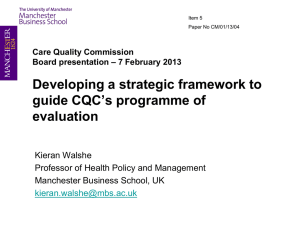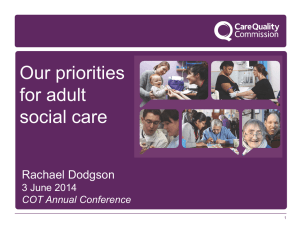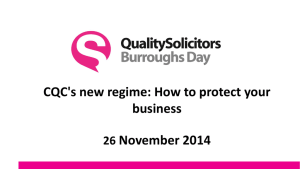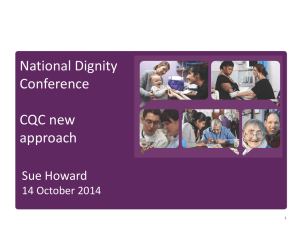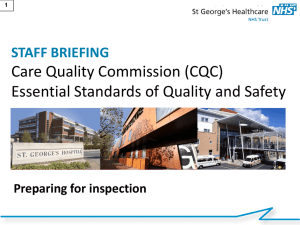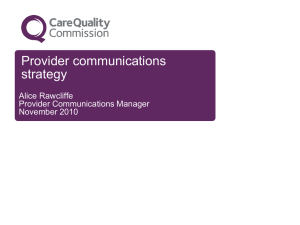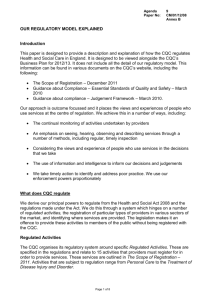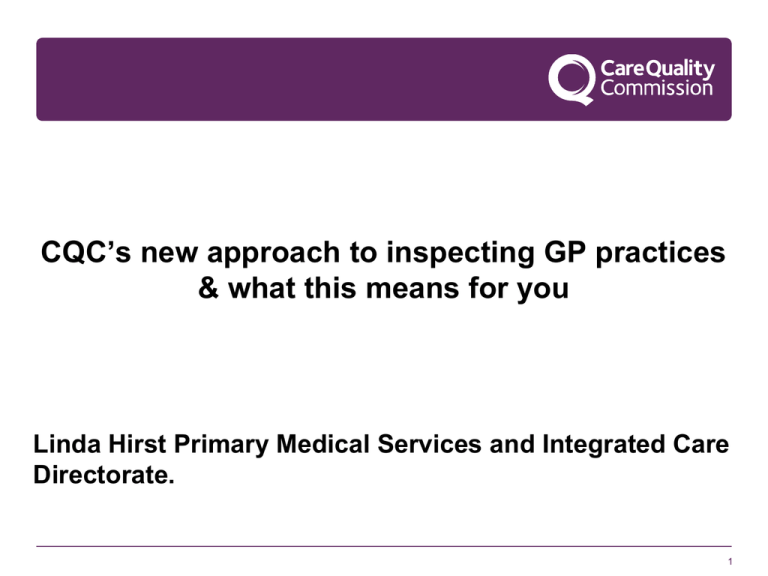
CQC’s new approach to inspecting GP practices
& what this means for you
Linda Hirst Primary Medical Services and Integrated Care
Directorate.
1
About CQC
Our purpose
• We make sure health and social care services provide people with safe, effective,
compassionate, high-quality care and we encourage care services to improve.
Our role
• We monitor, inspect and regulate services to make sure they meet fundamental
standards of quality and safety and we publish what we find, including performance
ratings to help people choose care.
Our principles
• We put people who use services at the centre of our work.
• We are independent, rigorous, fair and consistent.
• We have an open and accessible culture.
• We work in partnership across the health and social care system.
• We are committed to being a high performing organisation and apply the same
standards of continuous improvement to ourselves that we expect of others.
• We promote equality, diversity and human rights.
•Types of Inspection
• Scheduled, Responsive, Themed
2
Our new approach and why we changed
• We changed in response to the findings of public enquiries. We consulted widely about
what our new approach should look like. We have radically restructured. We now have
three directorates
• We have completely changed the way we monitor, regulate and inspect
• We use intelligent monitoring to decide when, where and what to inspect, including
listening better to people’s experiences of care
• When we inspect we will answer the following questions
• Is the service safe?
• Is the service effective?
• Is the service caring?
• Is the service responsive?
• Is the service well-led?
3
Our new approach
• We will use the information we gather on inspections to help us rate the quality of the
service and we will publish this rating to enable people using services to make informed
decisions about health and social care services. We will publish ratings on GP services
from October 2014 continuing until April 2016.
• The ratings are:
• Outstanding
• Good
• Requires Improvement
• Inadequate
• Services receiving a rating of requires improvement or inadequate will result in a
regulatory response and more frequent inspections. They will not all be announced.
• New legislation and Regulations to underpin our approach are at an advanced stage.
4
Our new approach
5
How we inspect
•
Inspections of a number of practices carried out in a CCG area over a 2-4 week period.
We will visit each CCG, probably every six months, inspecting a quarter of practices in
that area each time we visit. We will meet with Area Teams and CCGs before and after
inspections of practices in the area.
•
We will gather intelligence about the practice, the health information profile of the CCG
and will look at intelligence from QOF data (if available), patient survey data, comments
and ratings on NHS Choices, intelligence from NHS England. We will look at the practice
website (if available). We will take account of direct concerns and complaints received
from patients, information from whistleblowers, information from stakeholders and
professional bodies (GMC, NMC, HPC). We will use information from listening events
and from other directorates to identify any information of good practice or areas of
concern. We will use this information to target and plan our inspections.
•
We will announce our inspections in advance and will be in touch to explain our
inspection, who will be part of the inspection team, the process we will follow and to
answer any initial questions you may have.
6
How we inspect
• When their planning is completed and signed off by their inspection manager, our
inspectors will supply you with a proposed timetable for the day and a poster to display in
the practice. They may provide you with a list of documents and information they will wish
to see in advance to enable you to prepare. They will negotiate an arrival time (usually
ahead of practice opening to enable questions.
•We will have a specialist inspection team which will comprise one or more inspectors
from CQC, a GP advisor, a practice manager advisor and on occasion an expert by
experience or a pharmacist inspector (if you are a dispensing practice).
•The inspection team will always
• Speak to patients – it is helpful (if possible) to have a private room to facilitate this.
•Observe interactions between practice staff and patients – this will NOT involve sitting in
on patient consultations unless there is a very good reason for this and the patient agrees.
•Speak to a range of practice staff (all designations) – think in advance how you can
facilitate this.
7
How we inspect
• Inspect the practice in respect of; cleanliness and infection control, safety of premises,
safety of equipment, confidentiality of patient records, safety of medicines and prescribing
practices. Think about these areas and be prepared for questions, to be asked for audits
and action plans.
•We may look at patient records if there is a specific need to do this – this will usually be
because we have highlighted a risk to patients. We will ask our GP advisor or an inspector
will do this. We will never ask an expert by experience to look at patient records. We are
developing guidance on this issue.
•We will ask you to arrange for us to meet/have a telephone discussion with members of
your PPG (if you have one). If not be prepared to answer questions about how your
practice obtains the views of patients and uses these to arrive at a decision about the
quality of patient care and service.
•If your practice has more than one branch we may visit other branches.
•We will ask about your clinical audits. Clinical Audit is defined by HQIP and endorsed by
NICE as: ‘a quality improvement process that seeks to improve patient care and outcomes
through systematic review of care and the implementation of change.’
8
Clinical audit
• Clinical Audit is a process or cycle of events that help ensure patients receive the right
care and the right treatment. This is done by measuring the care and services provided
against evidence base standards, changes are implemented to narrow the gap between
existing practice and what is known to be best practice. Ideally, a clinical audit is a
continuous cycle that is continuously measured with improvements made after each cycle.
9
How we inspect
We will always look at services at a location (GP practice) level through the lens of six
patient groups. For every NHS GP practice we will look at the quality of care for the
following key patient groups:
•
Older people (over 75s)
•
People with long term conditions
•
Mothers, babies, children & young people
•
Working age population and those recently retired
•
People in vulnerable circumstances who may have poor access to primary care (Eg
homeless people, people with drug or alcohol dependency, sex workers, travellers,
people with learning disabilities. This is not an exhaustive list)
•
People experiencing a mental health problem
•
Think about what your service provides and elements of outstanding practice and be
prepared to let us know about this.
10
How we inspect
• Expect inspections to last the whole day or in large practices or where there are
complex issues possibly two days.
•The inspection team will provide headline feedback at the end of each inspection. They
will not be able to tell you your quality rating.
•If there is any evidence of immediate risk to patients this will be brought to your attention
on the day.
•You will receive a draft report and you have 10 days to comment on factual accuracy
only. You will receive a response if you make factual accuracy comments with the final
report. The report will then be published
11
Top Tips for Inspections
• We will still inspect against the current Health and Social Care Act 2008 and Regulated
Activities Regulations 2010 until the Care Bill 2014 is enacted. The current Guidance
About Compliance will help you to interpret the Regulations. Be aware of and have read
these key documents and think about how your service ensures these are being met
• Know your service and tell the inspection team about it, providing evidence of this. We
must corroborate our findings. Tell us what you do well and also what needs to improve
and crucially what you are doing to improve it. Remember it is your legal obligation to
identify, assess and manage risks. Think about how you manage risks at a patient and
practice level.
• Ensure your staff relax and are honest. We do not expect perfection, but we expect you
to strive for improvement and to ensure patients are protected from harm and receive a
good quality, responsive and caring service. We will ask a lot of questions, some will be
quite searching, we are looking at the impact of what you do on patient care and welfare.
•If we set requirements, make sure you send in SMART action plans within the timescales
set. It is an offence not to!
•Make sure the registration of your service is right!
12
Links to useful information
Our website
www.cqc.org.uk
Notifications
http://www.cqc.org.uk/content/notifications-gp-providers
Making changes to your registration
http://www.cqc.org.uk/content/application-form-finder
About our inspections
http://www.cqc.org.uk/content/how-we-inspect-gps-and-primary-medical-services-whenthey%E2%80%99re-registered
About our new approach
http://www.cqc.org.uk/sites/default/files/documents/20131211__gp_signposting_statement_-_final.pdf
13
References
•Consultation on provider handbook
http://www.cqc.org.uk/sites/default/files/20140409_provider_handbook_consultation_gp_pr
actices_final_for_web.pdf
Guidance about compliance
http://www.cqc.org.uk/sites/default/files/documents/guidance_about_compliance_summary.
pdf
Health and Social Care Act 2008 Regulated Activities Regulations 2010
http://www.cqc.org.uk/sites/default/files/documents/health_and_social_care_act_2008_reg
ulated_activities.pdf
14
Thank you for listening
Any questions?
15

